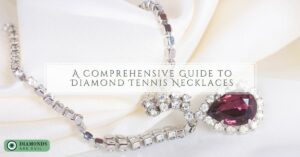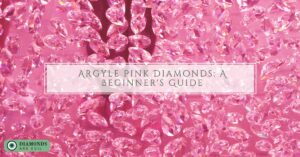Colorful Lab Diamonds: Today, it’s no longer a secret that lab diamonds have the same characteristics and properties as the natural ones that need to be mined from the earth. Moreover, the lab diamonds are suitable for any use or purpose, as well as the natural diamonds. The question remains – what happens in terms of the color of the diamond. Due to the fact that laboratory diamonds are not made of material mined in natural mines and minerals – you do not have to overcome the issue of the color that may soothe the diamond and reduce its value during mining, or vice versa, you can add color in a controlled way for the diamond to be perfectly match to the jewelry that it should be embedded in or when the color is supposed to make the diamond much more beautiful.
What does the color of the diamond itself mean?
Color plays a very important role in lab diamonds. On the one hand, the diamond must be perfectly transparent and shiny to make it difficult (or impossible) to distinguish it from a real and natural diamond. The different ratings that diamonds are tested for are directly related to the degree of transparency and light reflectance of the diamond’s surface, two qualities that are directly related to the lack of color. On the other hand – we all know diamonds that have a certain color and there is no bear, god forbid, a defect or a manufacturing failure. It is a color that is selected and remains in the diamond after careful thought while deliberately performing actions. When encountering a laboratory diamond that has a delicate color – do not disqualify its use outright, as it may very well have a specific purpose and the color should fit into that designation.
Colors of diamonds
Diamonds exist in nature in all rainbow colors but are very rare and hence – are very expensive. This fact brings with it the intuitive thought that if diamonds are produced under laboratory conditions, it is also possible to artificially insert a certain color, control its shade and thus perfectly match it to jewelry like diamond necklaces and tennis bracelets or where it should be inlaid. At the same time, colored diamonds are not considered to be very desirable, since even those who are never connected to the diamond known professionally that in order for the diamond to look the most special, prestigious and luxurious it must be the most transparent and of course flawless. Colorful diamonds appear to many people to be much less prestigious, so there is a clear preference not to purchase them. The monetary price also gives its contribution and the combination of the price with the less fancy appearance of the diamond makes the colored diamonds less wanted. Laboratory diamonds are manufactured under controlled conditions, save high costs and can be produced in interesting ways that cannot be used in the natural way. Raw materials are also different from those found in the depths of the soil and therefore have different properties that can also affect the finished product – the ready-made diamond. In laboratory conditions, colored diamonds can also be produced, thus changing the mindset of the general public towards those diamonds that have a touch of color, subtle tint or completely painted interior.
Gradually, as lab diamonds use will grow, there is no doubt that colored diamonds will come into consciousness and will not have a negative opinion based on the lack of transparency or brilliance. Colorful diamonds can also remain translucent, shiny and beautiful, as well as reflect light from all their interior space. This is no doubt a major and important contribution of the world of synthetic diamond production to the entire field.
When to use colored laboratory diamonds
As mentioned, there are quite a few cases where the color of the diamond is needed, so that the diamond fits well in its intended place. The main place where you can see this – the jewelry world. Whether it is a unique color that is deliberately inserted into the diamond or a lower grade of cleaning that is deliberately achieved, the diamond will surely fit much better into the jewel where you want to embed it. For example, if it is a diamond ring or diamond earrings made of yellow gold, here the transparent diamond will not fit and look like a foreign plantation. When the diamond has a subtle yellow hue, light brown or slightly controlled turbidity – it will fit very well into the frame within which the piece will be glued to the jewelry and the entire jewelry will look just as perfect. These will be the considerations of the lab technician when making a colored diamond. When it comes to bright and strong colors – there is no limit to the imagination and the person who orders the diamond can choose or even personally order the diamond according to his preferred criteria and features – size, shape, color – to the point of choosing the exact shade. He may do this to make the diamond fit his existing jewelry collection, maybe he wants to break through the intuitive line of thinking and choose a diamond that no one has this color or he’ll just be curious to see what a beautiful, special and spectacular diamond looks that have a special feature of color that you can’t see anywhere else. Luckily, the controlled production conditions in the lab allow this and thus infinitely increases the options available to those looking for unique, beautiful diamonds that will look exactly how they want.
Colorful laboratory diamonds and prices
The insertion of the paint into the diamond body during the production process is a challenging operation, but the laboratory conditions give it a response and it is now quite possible. Many people prefer the diamonds produced in the laboratory because they allow a lot of features that do not exist in the natural diamonds or that make the natural diamond so expensive. Scientists are constantly developing and renewing the field of laboratory production, and diamond painting gets a place of honor. The goal of diamond production in the lab is divided between a significant reduction in diamond production and the renewing of known ways and success in performing operations that so far have not been possible in the natural production process. From this it is easy to understand that there are many advantages to artificial production and there is a considerable scientific and consumer breakthrough here. All that remains now is to allow researchers and scientists to continue research and experimentation and to monitor the findings they publish from time to time. Certainly, over time diamond painting will also become a routine operation and those diamonds will be beautiful without their value being lower. It is important to remember that the production of diamonds in the laboratory is a great news both to the science world and to the jewelry and diamond world. In this process there is a great deal of humanity, quiet and tremendous advantages over the precious diamond mining in the natural resources (which in any case has been steadily declining over the years all over the world). Lab diamonds are produced in positive, pleasant ways and most importantly – ways of peace. Whether it is transparent lab diamonds or colored lab diamonds – the way the lab diamonds are produced is a good and positive way of supporting them, pointing their feet, and showing a willingness to accept other and modern ways of achieving traditional goals. Over time, the ways and actions can become even more sophisticated, as science is not marching in place and no doubt the diamond world will benefit quite a bit from that as well. About us, the people at the end of the production chain – there are a few tasks here – spread the news, favor the diamonds produced in good and positive ways and of course tell about the good qualities of diamonds among our acquaintances.






